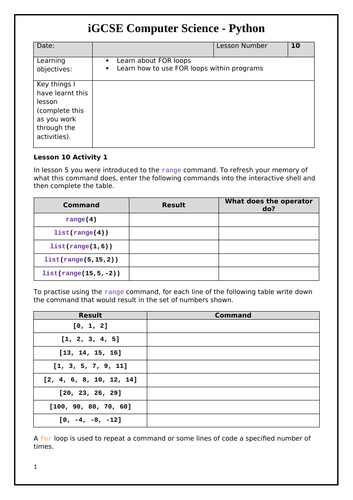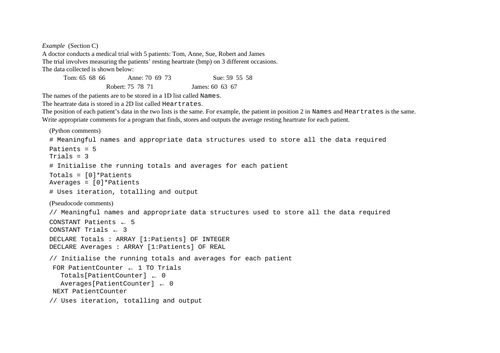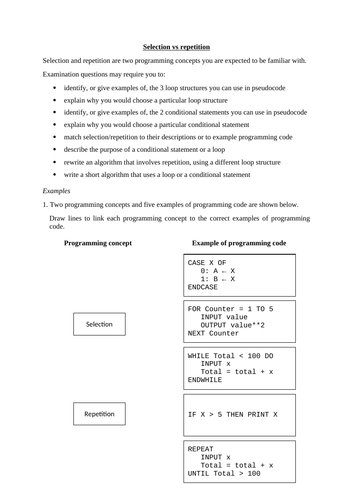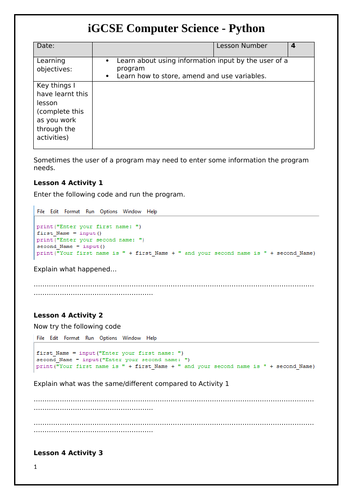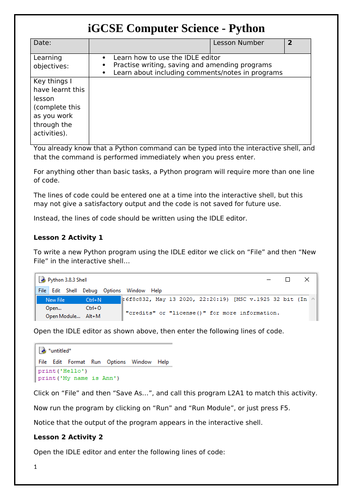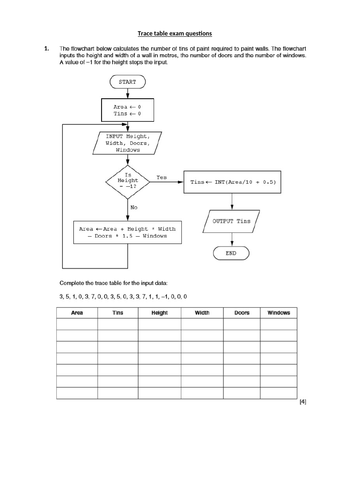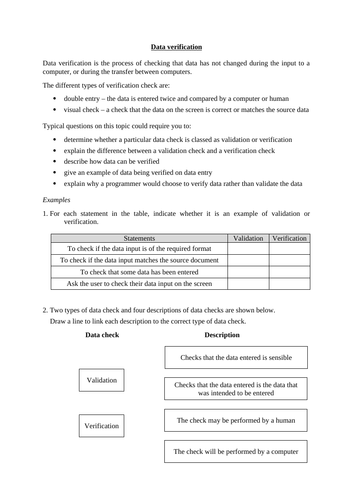31Uploads
9k+Views
6k+Downloads
All resources

FOR loops in Python
This 8-page booklet introduces how FOR loops work within Python, giving pupils lots of practise using them in programming activities. Nested FOR loops are also covered.
The booklet is designed for pupils to work through independently, so they can progress and learn at their own pace and you just support and guide as necessary.
Solutions are included in a separate booklet.

15 mark unseen scenario question - 0984 iGCSE Computer Science (final question on paper 2)
This resource is designed to help students develop and practise the skills and knowledge needed to answer the final 15-mark question on Paper 2 - a programming task on a particular scenario.
Section A focuses on choosing and defining/declaring appropriate data structures for storing the required data. There are notes with some examples, then a 3-page exercise for students to practise this part of the task.
Section B focuses on identifying the programming technique(s) needed to solve different types of programming tasks. There are notes with some examples, then a 3-page exercise for students to practise this part of the task.
Section C shows students what types of comments they are expected to write to explain their code. It shows the typical structure of comments for both Python and pseudocode, and then there is an example task to work through as a class.
Section D is a chance for students to practise writing full solutions to tasks that involve only 1D lists. There is an example to work through as a class, followed by an exercise with 18 tasks of increasing difficulty, including some tasks that require a procedure or a function.
Section E is a chance for students to practise writing full solutions to tasks that involve 2D lists. There is an example to work through as a class, followed by an exercise with 17 tasks of increasing difficulty, including some tasks that require a procedure or a function.
Full solutions are provided to all the tasks in the exercises, written in both Python and pseudocode. Solutions to the examples are also provided in a separate resource.

Christmas activity with Python
A Christmas-themed activity where students will use/learn programming skills.
This booklet leads students through the creation of a Christmas scene using drawing commands with Python turtle. It does not require any prior programming knowledge, and is designed so that students can progress independently through the tasks.
When I use this with my year 10 classes it takes them around 1 hour to complete.
Example solutions to all the tasks are included in a separate booklet.

Using AND, OR and NOT in Python
This booklet introduces how the commands AND, OR and NOT can we used within conditional statement in Python. There are several programming activities at the end of the booklet for pupils to attempt.
The booklet is designed for pupils to work through independently, so they can progress and learn at their own pace and you just support and guide as necessary.
Solutions are included in a separate booklet.

Selection vs repetition (iGCSE Computer Science)
This resource focuses on the two programming concepts of selection and repetition.
It begins with the expected knowledge/skills for this topic, followed by a few examples to work through as a group. Finally, there is an exercise of 12 exam questions taken from past papers.
Solutions (mark schemes) are included for the exercise, and notes/solutions to the introduction and examples are included in the teacher’s version,

Introduction to Python - printing
This short booklet can be used as an introduction to the Python programming language. After a short introduction activity, pupils practise typing commands into the interactive shell to learn how the print command works.
The booklet is designed for pupils to work through independently, so they can progress and learn at their own pace and you just support and guide as necessary.
Solutions to all activities are included in a separate booklet.

Using the input command in Python
This short worksheet introduces how the input command allows the user of a Python program to enter strings, and how to store the input.
The booklet is designed for pupils to work through independently, so they can progress and learn at their own pace and you just support and guide as necessary.
Solutions are included on a separate sheet.

Using variables in Python programs
This short booklet introduces how variables are defined and used within Python.
The booklet is designed for pupils to work through independently, so they can progress and learn at their own pace and you just support and guide as necessary.
Solutions are included in a separate booklet.

Writing and saving Python programs using the IDLE editor
This short booklet shows pupils how they use the IDLE editor to write and save programs. It also shows how comments can be added within programs.
The booklet is designed for pupils to work through independently, so they can progress and learn at their own pace and you just support and guide as necessary.
Solutions are included in a separate booklet.

Trace table exam questions (iGCSE Computer Science)
This resource is based on a selection of 17 questions on trace tables taken from past papers.
The first document contains the exam questions, which can be printed for your pupils.
The second document is a spreadsheet designed to help the students get the trace tables correct before they fill in the printed document - as they fill in each cell within a trace table, it will stay black if it is correct, but turn red if it is wrong. This means they will be aware of any error as soon as they make it, rather than working through the whole table and only realising at the end that they need to make corrections.
The third document is the answers (mark schemes) to the questions.

Data verification (iGCSE Computer Science)
This short resource introduces the different types of verification checks a computer or person may perform.
There are some example questions to work through with your group, and answers are provided.

